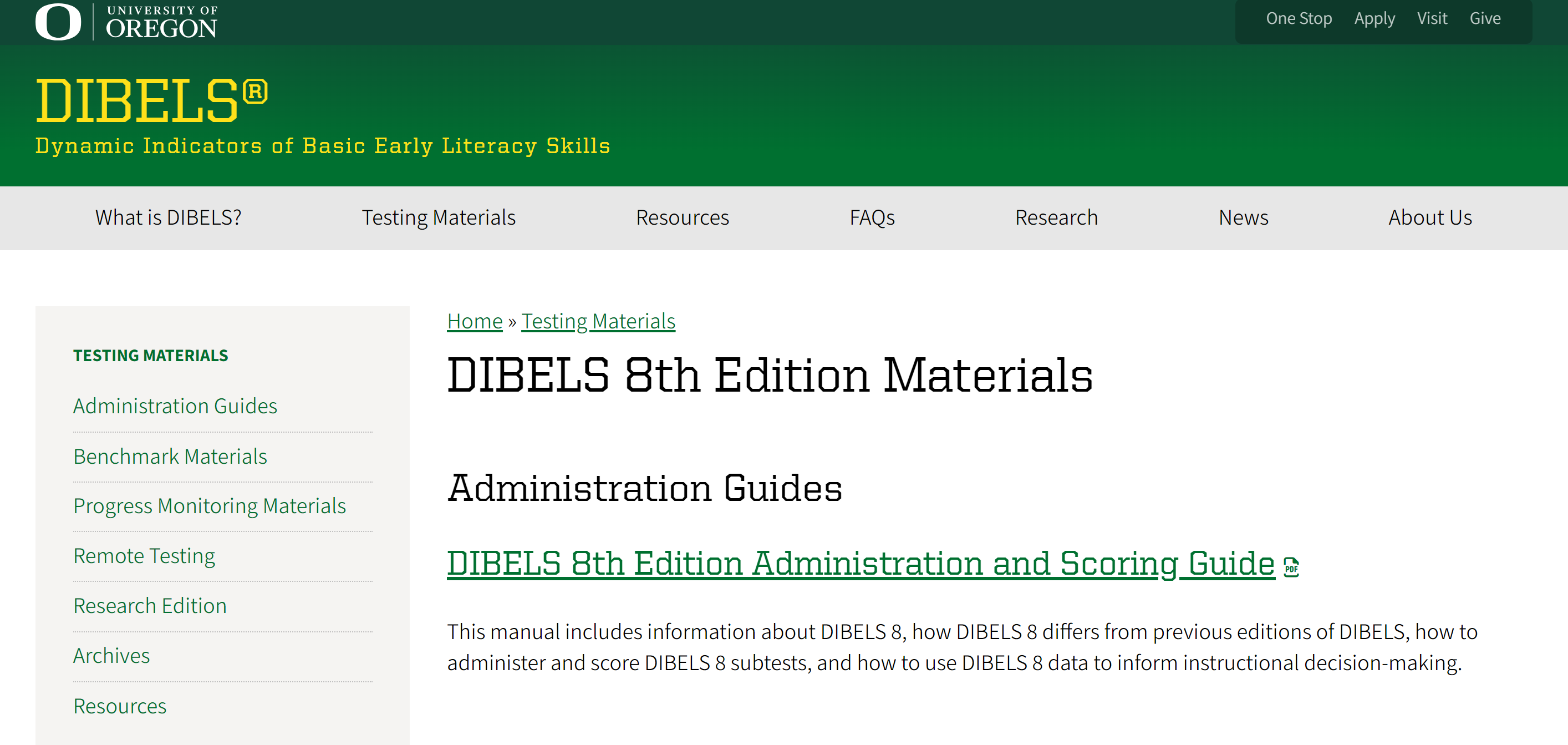Administrators’ Role in Developing an Evidence-Aligned Assessment Plan
By: Ryan Buggy, TRL Professional Development Team | April 25, 2024
Administrators’ Role in Supporting Effective Instruction
Administrators play an important role in ensuring that teachers have the time and resources they need to provide effective instruction. One of the best ways administrators can support their teachers is by providing them with high-quality assessment data while minimizing the amount of instructional time spent on its collection and analysis. It is important for schools to collect and analyze literacy data that measure all foundational skills necessary for skilled reading (e.g. phonemic awareness, decoding, language comprehension), going beyond just the comprehension measures included in a typical reading program. Many schools invest in platforms such as DIBELS or Acadience to assist in collecting this data, as well as other materials useful for measuring students’ oral language proficiency.
Assessment and the Simple View of Reading
When choosing assessments, it may be helpful to consider the simple view of reading. Remember that one component of the simple view is “word recognition,” or a reader’s ability to get words off the page fluently and accurately. The other component is called “language comprehension,” which broadly refers to one’s vocabulary, verbal reasoning, background knowledge about a given subject, and other skills that allow us to make meaning of language. Reading comprehension is the product of both word recognition and language comprehension together; however, we often want to assess these two pieces independently in order to identify specific instructional needs in each domain. That is to say, reading comprehension assessments alone are not enough to guide instructional decisions, as they may not allow educators to disambiguate students who have weaknesses in word recognition from those who have weaknesses in language comprehension (or those who have needs in both areas).
Assessing Word Recognition
Some of the most widely used, research-validated measures of word recognition skills are curriculum-based measures (CBMs). Examples of CBMs include letter-sound fluency, phoneme segmentation, oral reading fluency (ORF), and more. These are standardized, timed, and brief assessments—each one typically only takes one minute to complete—that allow educators to screen for word recognition difficulties as well as to monitor students’ progress and ensure the efficacy of their instruction. Many of these measures are highly correlated with reading comprehension; indeed, for early elementary students, the correlation between oral reading fluency (ORF) and reading comprehension is as high as 0.90 (Shinn et al., 1992). Many districts use ORF as their primary reading screener in Grades 1-5, sometimes in addition to a separate screener that targets oral language comprehension. In summary, CBMs are strong choices for administrators looking for valid, reliable assessments that are quick to administer and provide useful data for identifying who may be at risk and who is making adequate progress with the given instruction. While districts often purchase CBM materials as part of an assessment suite, there are also paper-and-pencil testing materials available for free via the University of Oregon’s DIBELS 8th Edition.
Assessing Language Comprehension
Language comprehension is a wide-ranging set of skills, including students’ vocabulary, their background knowledge related to a particular subject, their ability to understand syntactic relationships within sentences, their verbal reasoning, and more. Furthermore, students may have strengths and needs in more than one language, and having a full understanding of their linguistic repertoire is essential in guiding instructional decisions.
Although the breadth of the language comprehension domain can make it less straightforward to operationalize and assess, there are a few key principles to keep in mind. First, schools should have a plan to screen students for developmental language disorder (DLD), which occurs at approximately the same rate as dyslexia and describes students who have difficulty in both expressive and receptive language. For more information about DLD screeners, administrators might consult the recommendations in this Review Article by Bao et al. (2024), also available in this Oral Language Screeners spreadsheet created by the authors. While most of these screeners are available for purchase, some materials are freely available, such as the paper-and-pencil version of the CUBED Narrative Language Measures. Second, schools should develop a plan to assess students’ language proficiency in all languages they know. This is because proficiency in one’s first language is related to one’s ability to acquire additional languages. For more information about what administrators should know about reading assessments for English Learners/Emergent Bilinguals, consider reading Dr. Lilian Durán’s overview published on The Reading League’s Compass.
One key takeaway from the research on reading assessments is that assessing reading comprehension alone is not enough. Reading comprehension is primarily the product of underlying skills in word recognition and language comprehension, and it is necessary to measure these skills independently in order to identify and attend to students’ instructional needs. While comprehension assessments such as state tests may be useful in identifying broad trends and comparing schools to one another using the same scale, administrators must develop strategic plans to screen for and diagnose domain-specific reading abilities.
Screeners, Diagnostics, and Progress Monitoring Tools
The typical assessment strategy involves a combination of screeners, diagnostics, and progress monitoring assessments. Screeners are used to identify students with potential reading difficulties, as well as to examine overall trends in a school and plan for how best to allocate instructional resources. These are designed to be as efficient as possible—generally no more than 10-15 minutes per student—minimizing the amount of time taken away from instruction while still providing valid and reliable data. If a student is flagged by a screener, the next step is to dig deeper using a diagnostic assessment, which takes inventory of the full range of a student’s abilities, pinpointing specific weaknesses that may guide future instruction.
Since these diagnostic assessments can be more time-consuming than screeners, avoid giving them to students whose previous assessment data did not indicate any significant weaknesses. Finally, progress monitoring assessments can be used to monitor the growth of students receiving targeted interventions, ensuring that the instruction they are receiving will be sufficient in closing the gap in their skills. Remember that any time spent on assessment is time taken away from instruction; as such, avoid giving multiple assessments that are designed to answer the same question (e.g., “Is this student on track?”), and be sure to select the most efficient assessments that still provide accurate data. If a “screener” takes more than a few minutes per child, it is probably not the most efficient option! For more information about the types of questions that each assessment can answer, consider reading Uses and Misuses of Commercial Reading Assessment: An Applied Framework for Decision Making in Grades K through 6 (Truckenmiller et al., 2024) that frames various popular assessments in terms of the type of decisions they can help educators make.
The Four C’s of Assessment
In planning your school’s assessment strategy, administrators can remember the four C’s of assessment: Collect, Communicate, Connect, and Come back.
Collect: Make a plan for when you will collect assessment data throughout the year and who will be responsible for doing so. This plan will include allocating time for your assessment team (paraprofessionals, reading interventionists, etc.) to receive training on assessment protocols and calibrate their scoring, and then enough time to ensure that every student is assessed using curriculum-based universal screeners. Your assessment strategy should include efficient screeners to identify students with potential reading difficulties and then diagnostic assessments for students flagged by your screener(s) that will allow you to identify specific needs and plan appropriate instruction.
Communicate: Although you will likely ask non-teaching staff to help administer at least some of these assessments, it’s important that classroom teachers understand their students’ data and its implications. If you use an assessment platform, ensure your teachers understand which reports are most useful to them and provide them with common planning time to go through each student’s results. If there are any building-wide trends you notice—for example, particularly low scores in phoneme segmenting among first graders—be sure to address these concerns with teachers, who may not have the same bird’s-eye view afforded to administrators.
Connect: High-quality data allows us to connect our instruction to individual students’ needs. One way to do so is by providing time within your daily schedule for more individually tailored instruction, such as a WIN (What I Need) block or a Walk-to-Learn period. During this time, you can organize students based on their data (for example, students who do not yet know a particular letter-sound correspondence or who require additional time developing their oral language skills) and communicate each group’s instructional goals to their teacher. This allows teachers to target their instruction as efficiently as possible, connecting assessment data to their lesson planning.
Come Back: After universally screening all learners, there may be certain students whose scores indicate that they are more significantly below benchmark than their peers. For these students, it is especially important to collect progress monitoring data in order to ensure that the intervention they are receiving is effective in bridging the gap in their reading ability. This often means collecting biweekly data in between benchmarking windows, so that if you need to make any changes, you have current data available to you.
Conclusion
While teachers are the ones working directly with students in the classroom, administrators play an important role in supporting instruction, making decisions, and allocating resources. By providing teachers with assessments that emphasize the efficient collection of actionable data—and the time they need to respond to it—administrators can ensure that all students have the greatest chance of becoming skilled readers.

